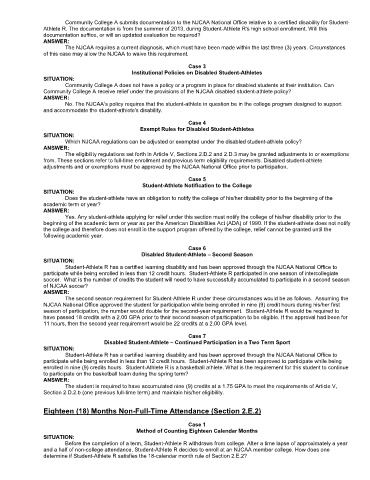Page 263 - 2019-20 NJCAA Handbook - May, 2020
P. 263
Community College A submits documentation to the NJCAA National Office relative to a certified disability for Student-
Athlete R. The documentation is from the summer of 2013, during Student-Athlete R's high school enrollment. Will this
documentation suffice, or will an updated evaluation be required?
ANSWER:
The NJCAA requires a current diagnosis, which must have been made within the last three (3) years. Circumstances
of this case may allow the NJCAA to waive this requirement.
Case 3
Institutional Policies on Disabled Student-Athletes
SITUATION:
Community College A does not have a policy or a program in place for disabled students at their institution. Can
Community College A receive relief under the provisions of the NJCAA disabled student-athlete policy?
ANSWER:
No. The NJCAA’s policy requires that the student-athlete in question be in the college program designed to support
and accommodate the student-athlete's disability.
Case 4
Exempt Rules for Disabled Student-Athletes
SITUATION:
Which NJCAA regulations can be adjusted or exempted under the disabled student-athlete policy?
ANSWER:
The eligibility regulations set forth in Article V, Sections 2.D.2 and 2.D.3 may be granted adjustments to or exemptions
from. These sections refer to full-time enrollment and previous term eligibility requirements. Disabled student-athlete
adjustments and or exemptions must be approved by the NJCAA National Office prior to participation.
Case 5
Student-Athlete Notification to the College
SITUATION:
Does the student-athlete have an obligation to notify the college of his/her disability prior to the beginning of the
academic term or year?
ANSWER:
Yes. Any student-athlete applying for relief under this section must notify the college of his/her disability prior to the
beginning of the academic term or year as per the American Disabilities Act (ADA) of 1990. If the student-athlete does not notify
the college and therefore does not enroll in the support program offered by the college, relief cannot be granted until the
following academic year.
Case 6
Disabled Student-Athlete – Second Season
SITUATION:
Student-Athlete R has a certified learning disability and has been approved through the NJCAA National Office to
participate while being enrolled in less than 12 credit hours. Student-Athlete R participated in one season of intercollegiate
soccer. What is the number of credits the student will need to have successfully accumulated to participate in a second season
of NJCAA soccer?
ANSWER:
The second season requirement for Student-Athlete R under these circumstances would be as follows. Assuming the
NJCAA National Office approved the student for participation while being enrolled in nine (9) credit hours during his/her first
season of participation, the number would double for the second-year requirement. Student-Athlete R would be required to
have passed 18 credits with a 2.00 GPA prior to their second season of participation to be eligible. If the approval had been for
11 hours, then the second year requirement would be 22 credits at a 2.00 GPA level.
Case 7
Disabled Student-Athlete – Continued Participation in a Two Term Sport
SITUATION:
Student-Athlete R has a certified learning disability and has been approved through the NJCAA National Office to
participate while being enrolled in less than 12 credit hours. Student-Athlete R has been approved to participate while being
enrolled in nine (9) credits hours. Student-Athlete R is a basketball athlete. What is the requirement for this student to continue
to participate on the basketball team during the spring term?
ANSWER:
The student is required to have accumulated nine (9) credits at a 1.75 GPA to meet the requirements of Article V,
Section 2.D.2.b (one previous full-time term) and maintain his/her eligibility.
Eighteen (18) Months Non-Full-Time Attendance (Section 2.E.2)
Case 1
Method of Counting Eighteen Calendar Months
SITUATION:
Before the completion of a term, Student-Athlete R withdraws from college. After a time lapse of approximately a year
and a half of non-college attendance, Student-Athlete R decides to enroll at an NJCAA member college. How does one
determine if Student-Athlete R satisfies the 18-calendar month rule of Section 2.E.2?

